- The Oral B 3000 vs 5000: Which Electric Toothbrush Is Better? - February 27, 2022
- Kid Tested and Dentist Approved: The Five Best Natural Toothpaste for Kids - February 17, 2022
- Need Orthodontic Treatment, But Not a Fan of Braces? The Five Best Braces Alternatives Available - February 7, 2022
Oral health is one of the most important parts of overall well-being for both children and adults. Keeping your teeth in good shape has obvious benefits. After all, you need your teeth to eat most foods. Poor oral health doesn’t just lead to tooth decay and cavities, though.
Failing to take care of your teeth and mouth appropriately can result in a wide range of issues, including:
- Red or swollen gums (also known as gingivitis)
- Pain and increased tooth sensitivity
- Cosmetic issues (such as white or brown spots along the teeth and gum line)
Good oral care is particularly important for children. While it may seem like cavities and other tooth issues are less of a big deal in small children, especially since they haven’t lost their baby teeth yet, setting up good habits for oral health at a young age is one of the most important indicators for good oral health later in life.
Additionally, oral health issues tend to compound over time. A child with poor oral health habits as a child may be more prone to severe oral health issues later in life, such as receding gums or even tooth loss.
One of the best ways to help your child develop positive oral health habits early on is by teaching them to brush their teeth with a high-quality toothpaste. The Center for Disease Control recommends that children brush their teeth twice daily for optimal oral health. However, many complications may arise from introducing your child to conventional toothpastes for the first time.
Many younger children don’t understand that toothpastes made with fluoride have to be spat out after use. Fluoride is an important chemical for tooth care that develops a protective layer around teeth through reacting with calcium, but excessive fluoride intake can result in various health issues, such as a stomach ache or even intestinal blockage.
It can be very stressful for parents to teach their children to brush their teeth for the first time, as many children take some time to learn not to swallow toothpaste. Fortunately, many companies create toothpastes using natural ingredients to help children learn to brush their teeth without swallowing excess fluoride.
Natural toothpastes also skip many of the additional synthetic chemicals used in conventional toothpastes, such as SLS (sodium lauryl sulfate, a foaming agent that can cause irritation for some people). You can even find natural toothpastes that use fluoride, in case you want some additional protection for your child once they learn to spit.
Bottom Line Up Front
Teaching your child good oral hygiene habits is extremely important, as it’ll help them build a foundation for healthy teeth later on in life. If you’re looking for the best natural toothpaste for kids, you can’t go wrong with Burt’s Bees Fluoride Free Kids Toothpaste. Affordable and yummy and completely safe, it’s a great choice for young mouths!
Other fantastic choices include:
- Jack N’ Jill Natural Toothpaste – Fantastic assortment of flavors for picky kids!
- Earth’s Best Toddler Toothpaste – Uses calcium lactate instead of fluoride!
- RiseWell Toothpaste – Boasts hydroxyapatite and a yummy cake batter flavor!
- Tom’s of Maine Children’s Toothpaste – An affordable option for older children!
A Brief History of Toothpaste for Kids
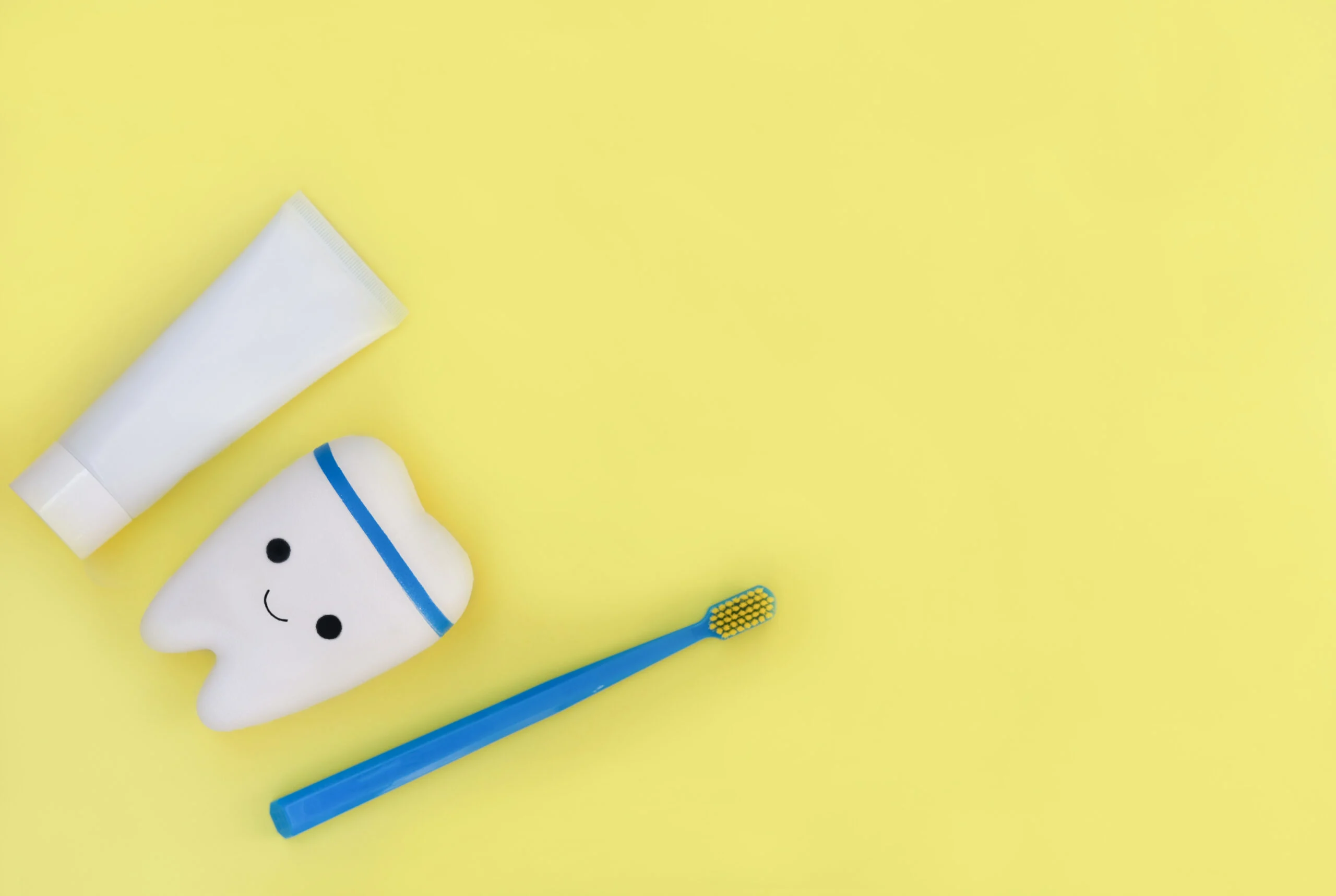
Toothpaste and teeth-brushing have both been a part of people’s everyday routines for thousands of years. Archeological evidence of ancient humans using pastes to clean their teeth dates back all the way to around 5000 B.C., when ancient Egyptians supposedly combined powdered ox-hooves, ashes, and burnt eggshells to keep their teeth clean.
While ancient toothpastes were very different from what we now know as toothpaste, the development of the modern concept of toothpaste began in the 1800s during the Industrial Revolution in Victorian England. Early versions of modern toothpaste often included ingredients such as soap, chalk, and betel nut.
In 1873, a young French company known as Colgate (yes, the same one we know today!) began to mass-produce a toothpaste named “Creme Dentifrice,” which was sold in jars. Then, a few decades later, Colgate introduced the familiar tube packaging for toothpaste in the 1890s.
Eventually soap was removed as an ingredient in 1945, and other modern synthetic ingredients were added to create the smooth minty concoction we know as toothpaste today. The sudden wave of modernization after the Second World War allowed for greater production and new synthetic chemicals to be used in making toothpaste.
It would not be until 1975 before so-called “natural” toothpastes would appear on the market. This arose as a sudden shift in consumer attitudes away from synthetics following the Vietnam War. Unlike the “natural” toothpastes of Ancient Egypt, though, today’s natural toothpastes contain ingredients such as peppermint oil, myrrh, and plant extracts.
The Benefits and Downsides of Using Natural Toothpaste for Kids
While natural toothpastes offer many advantages, particularly for children, there are also some drawbacks to using natural toothpaste that parents should be aware of before choosing one for their children. Here is everything you need to know about the benefits and downsides of using natural toothpaste.
The Benefits of Using Natural Toothpaste
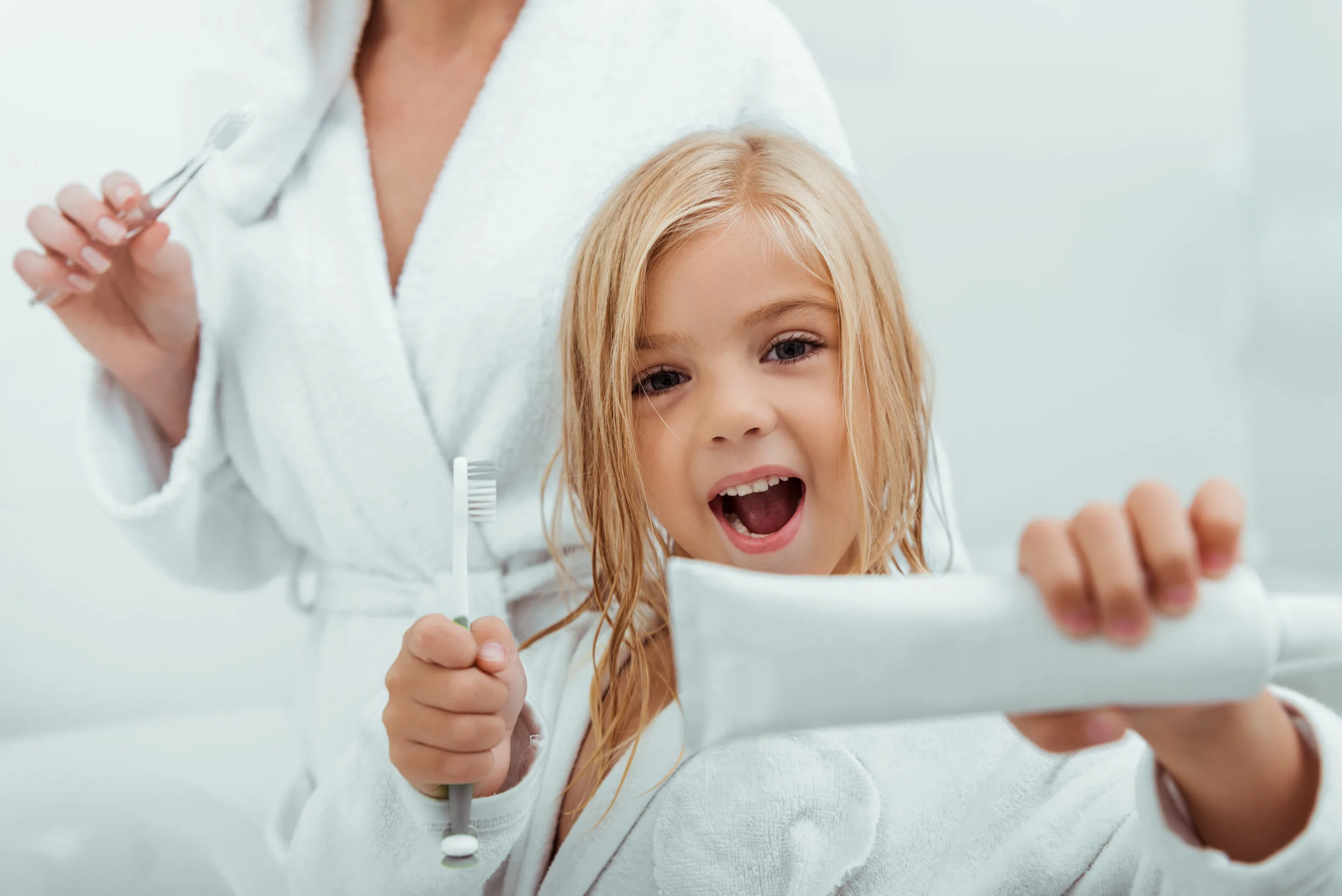
1. Natural toothpastes don’t contain any irritating chemicals.
One of the best reasons to use a natural toothpaste is to avoid the synthetic chemicals that are often used in conventional toothpastes. In addition to common synthetic ingredients such as SLS and Fluoride, many conventional toothpastes also use more dangerous synthetic chemicals, such as:
- Triclosan: A pesticide sometimes employed in toothpaste for antibacterial purposes
- Aspartame: An artificial sweetener that has been linked to migraines and seizures
- Parabens: A family of preservatives which can mimic the hormone estrogen
These ingredients can increase the risk of developing cancer, dizziness, and other health issues. By choosing to use a natural toothpaste, you can protect your child from various artificial substances.
2. Natural toothpastes without fluoride are safe for young children to swallow.
While fluoride is an important ingredient in conventional toothpastes, it’s better to use a fluoride-less natural toothpaste for children who haven’t yet learned not to swallow toothpaste. Even once children are able to rinse toothpaste out after brushing their teeth, natural toothpastes can still be better, as they don’t have many irritating synthetic chemicals.
3. Natural toothpastes are more gentle on young teeth.
Many conventional toothpastes use harsh exfoliants and other chemicals that can irritate new or developing teeth in children. Natural toothpastes designed for kids offer more gentle cleaning for young teeth, which can be perfect for children who are more prone to sensitive teeth or pain while brushing.
Be sure, however, to look for natural toothpastes advertising gentle cleaning or designed for children. Some natural ingredients, such as activated charcoal or baking soda, can be found in natural toothpastes. Designed for teeth whitening, these ingredients can act as very harsh exfoliants and should only be used by adults.
The Downsides of Using Natural Toothpaste
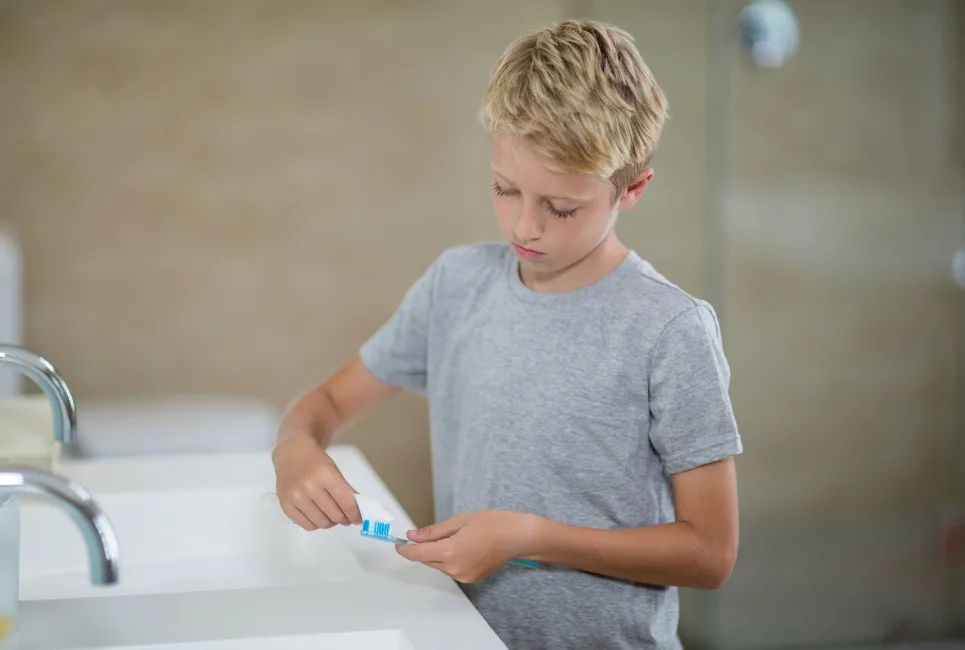
1. Natural toothpaste without fluoride may not be as effective in protecting teeth.
While there are benefits of fluoride-free toothpaste, they may make your teeth more prone to decay if used long-term. While fluoride may cause various adverse effects if ingested in large amounts, when used appropriately in toothpaste, fluoride acts as a vital ingredient in protecting teeth.
Fluoride reacts with the calcium on the surface of teeth, creating calcium fluoride, which can help keep teeth safe from cavity-causing bacteria. While the risk is low if you’re simply using fluoride-less toothpaste as a transitional step while teaching your child how to properly brush their teeth, you may not want to use them long-term.
Fortunately, many natural toothpastes incorporate fluoride into them. That way, you can have maximum teeth protection while still enjoying the benefits of high-quality natural ingredients – but without the synthetic chemicals used in many conventional toothpastes.
2. Natural toothpastes may be more expensive than their conventional counterparts.
Natural toothpastes often use higher quality ingredients compared to their conventional counterparts, such as:
- Coconut oil (or other essential oils)
- Sea salt
- Cacao nibs
While these ingredients allow for a healthy and non-irritating toothpaste, they also cost much more money for companies to source compared to the synthetic chemicals used in conventional toothpaste. Many companies making natural toothpastes are also smaller than Colgate or Crest and benefit less from economies of scale.
This means that the costs of production for companies that make these natural toothpastes tend to be greater, as they can’t purchase in bulk or transport supplies at the same scale as larger companies. In turn, natural toothpastes tend to be more expensive compared to their conventional counterparts.
However, with the benefits natural toothpaste offers young children, I’d still argue that they’re worth the added premium. If you’re working with a tight budget, however, that money might be put to better use.
3. Natural toothpastes may not be as effective at whitening compared to whitening toothpastes.
Finally, natural toothpaste doesn’t tend to have the same effectiveness at whitening compared to conventional toothpaste. This is particularly true for natural toothpaste made for kids.
Natural toothpaste made for children is specifically formulated to be as gentle and non-irritating as possible, while most natural whitening agents tend to be harsh on the surface of the teeth. That said, natural toothpastes for kids aren’t really meant for teeth-whitening.
Rather, they’re more designed to offer a healthier, safer alternative to conventional toothpaste for children just learning how to brush their teeth. If teeth whitening is a priority, consider purchasing whitening strips or other products designed specifically for teeth whitening.
The Main Differences Between Kid and Adult Toothpastes
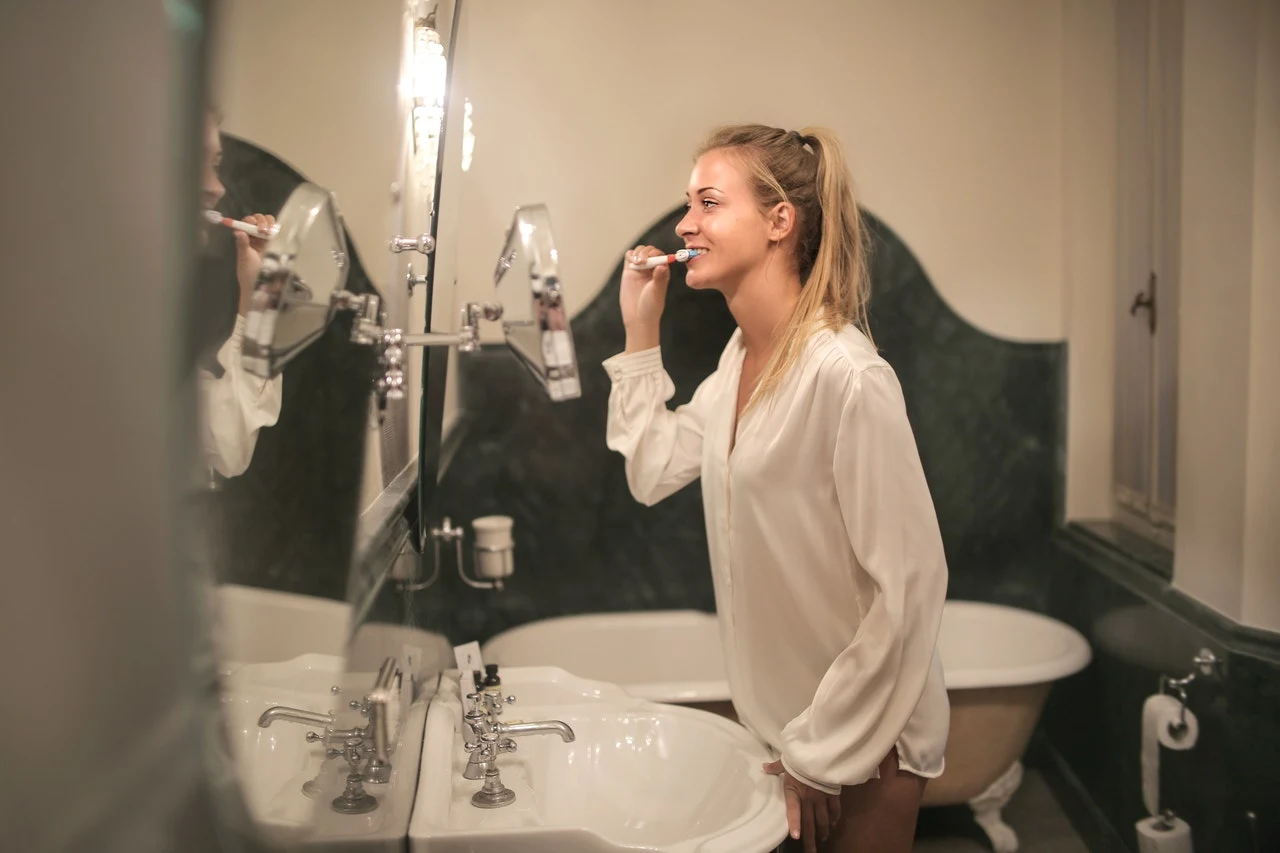
While both adults and children can use the toothpaste I’ve included in the list below, you may wonder what the difference between adult and children’s toothpaste is. After all, toothpastes formulated for children tend to be a bit more expensive compared to ordinary toothpaste.
Here are some of the top differences between adult and children’s toothpaste:
- Children’s toothpaste tends to have less (or no) fluoride content, whereas adult toothpaste generally does have fluoride included.
- Children’s toothpaste tends to be safer to swallow, whereas adult toothpaste should always be spat out after brushing.
- Children’s toothpastes tend to be less abrasive, whereas adult toothpaste tends to have harsher exfoliants.
- Children’s toothpaste tends to come in more flavors and colors, whereas adult toothpaste generally only comes in standard colors and minty flavors.
The Fluoride Content of Adult and Children’s Toothpaste
While I’ve talked about this already, it’s important to note that toothpaste specifically formulated for children tends to have less fluoride compared to fluoride formulated for adults. The reason for this is that children usually haven’t fully learned not to swallow toothpaste after brushing their teeth.
Fluoride can cause various health problems if ingested in excess, so children’s toothpaste has less fluoride content compared to adult or conventional toothpaste. While this makes the risk of children swallowing toothpaste lower, it’s also important to remember that children’s toothpaste offers a lower level of protection compared to adults’ toothpaste.
As a parent, you can help make up for the lower fluoride content in children’s toothpaste by keeping your child’s teeth safe in other ways. For instance, it’s a good idea to avoid feeding your child excessively sweet foods or soft drinks. In doing so, you can help make sure that your child’s teeth will be healthy for the long term.
The Safety of Swallowing Toothpaste
The lack of or lesser fluoride content is only one reason why natural children’s toothpaste is safer to swallow. Natural children’s toothpaste also uses much better ingredients in general compared to conventional toothpaste. Reading the ingredients list for natural toothpaste can almost feel like you’re reading the ingredient list for a high-quality recipe!
The ingredients used in natural toothpaste tend to be organic and food-grade, making them much safer to swallow compared to the synthetic chemicals in conventional toothpaste. This is particularly true for natural toothpaste designed for children.
Children’s toothpaste tends to be designed to be swallowed or at least designed with the ability to be swallowed in mind, while conventional toothpaste is explicitly designed to be spat out after use. The difference means that if your child does swallow their toothpaste after use, they’ll be much less at risk of any potential health issues.
The Abrasiveness of Adult and Children’s Toothpaste
Most adult toothpaste, both natural and conventional, will usually include some sort of abrasion agent to effectively remove plaque and other impurities from the surface of teeth. While this is true for children’s toothpaste too, the abrasion agents used in children’s toothpaste tend to be much more gentle, since children’s teeth are more prone to damage.
This is particularly true for natural toothpaste, which is why it’s so important for your child to use natural toothpaste specially formulated for children. Many adult natural toothpastes make use of activated charcoal, baking soda, sea salt, or other harsh abrasives, which can erode the enamel layer even on adult teeth after prolonged exclusive use.
The Flavors of Children and Adult’s Toothpaste
Finally, children’s toothpaste tends to come in a greater range of exotic or exciting flavors and colors compared to the traditional spearmint of adult toothpastes. There isn’t a scientific reason for this, either. It’s just more fun!
While many conventional kinds of toothpaste marketed towards children will often feature bright colors or popular characters from children’s media, the companies behind natural toothpaste usually don’t have the budget to license character art. Nevertheless, many of the toothpaste on my list come in fun flavors and colorful packaging to better appeal to children.
The Best Natural Toothpastes for Children Available
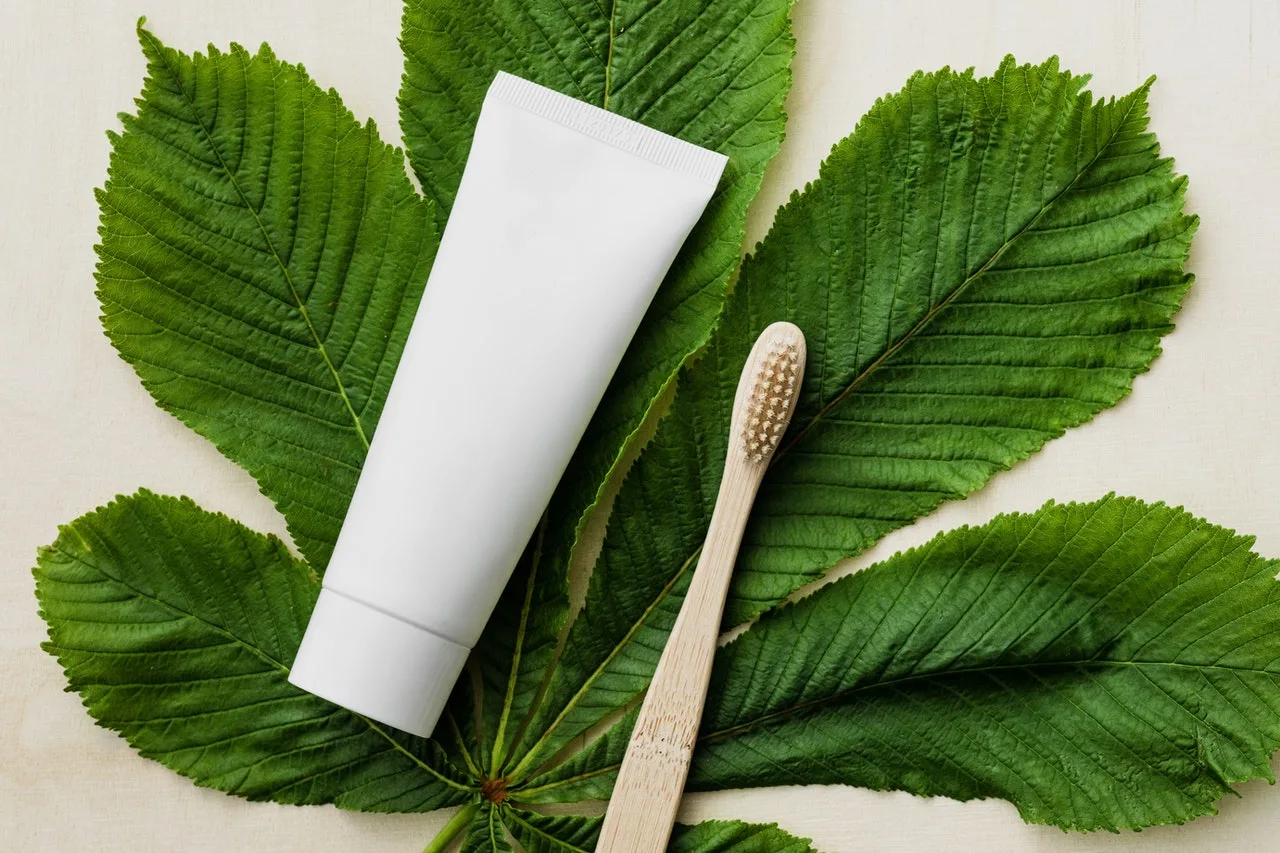
My Selection Criteria
Before we dive into my toothpaste picks, I want you to know exactly why I included a particular brand. In choosing the list of productions below, I’ve made sure to test and review each entry under a variety of criteria to make sure that you can find the best natural toothpaste for your child.
Teaching your child to brush their teeth for the first time is an important step in your child’s development. It’s also extremely important that your child has a positive association with brushing their teeth so that they’ll maintain good oral health habits later on in life.
With that in mind, here are the criteria I’ve used to pick the options below:
1. The quality of ingredients.
As always, the most important factor for all my product guides is quality. The whole point of natural toothpaste is that they’re safer and use better ingredients than conventional toothpaste. Because of that, I’ve made sure to only include natural toothpaste on this list with the highest quality ingredients.
Additionally, I made sure to avoid any products with ingredients that might cause harm to young teeth. This includes toothpaste that uses excessively abrasive materials or with high fluoride content.
A few options for children’s natural toothpaste that are formulated with fluoride have been included intentionally, in case any parents want to opt for a natural toothpaste that still retains the protective benefits of fluoride.
2. Their actual cleaning effectiveness.
I’ve also made sure that every single option listed below is highly effective at cleaning teeth. The importance of cleaning effectiveness is pretty self-evident, but I’ve gone one step further to ensure that these options are the very best in children’s natural toothpaste. Each one of the options below will keep your little one’s pearly whites sparkling for years to come.
3. If they appeal to children.
As every parent knows, children can be highly picky about what they use or wear. Picking a product that appeals to your child is particularly important for something like teaching your child to brush and floss their teeth since many children might already be experiencing anxiety or stress about learning to brush their teeth.
Every product on the list below has been examined for the variety of interesting flavors the brand offers, as well as a children-friendly packaging and exterior. By choosing a toothpaste with an appealing look, you can help make teaching your child to brush their teeth minimally painful for both you as the parent and your child.
4. Their overall retail price.
Finally, as always price has to be factored in. Since natural toothpaste is inherently more expensive than its conventional counterparts, the products below must be able to offer parents the best dollar value. While the products below vary in affordability, all of them offer what I consider an exceptional price-to-performance ratio.
Jack N’ Jill Natural Toothpaste
This fun, fluoride-free natural toothpaste comes in an adorable and friendly tube with a simple cartoon-style art design. Made from high-quality ingredients, such as coconut-derived glycerin and flower extract, Jack N’ Jill Natural Toothpaste is a fantastic option for children learning to brush for the first time.
The formula boasts no sugar, artificial coloring, parabens, or dairy and is SLS free. You can get Jack N’ Jill Natural Toothpaste in a variety of child-friendly flavors, too, such as:
- Milkshake
- Banana
- Strawberry
- Bubblegum
You can even get this toothpaste in a flavor-free version in case your child is sensitive to tastes. Perfectly safe to swallow, this toothpaste is an ideal choice for young children.
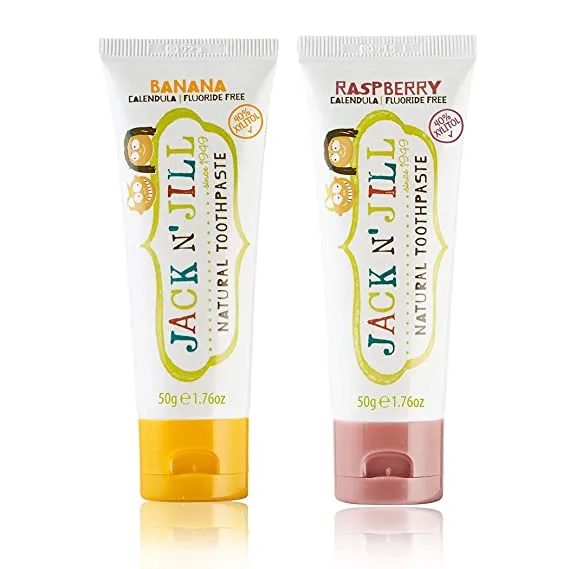
Pros
- Fun, child-friendly design
- Very wide range of unique and inviting flavors
- No harmful preservatives or artificial sweeteners
Cons
- Lack of fluoride means this toothpaste isn’t as protective as it could be
- Flavors may make initially make children more prone to swallowing
- Tubes are on the small side for what you pay
Earth’s Best Toddler Toothpaste
Although Earth’s Best Toddler Toothpaste is designed for children between the ages of six months and three years, its superior ingredients and safe-to-swallow properties make it a good choice for all children learning to brush for the first time.
The formula for Earth’s Best toothpaste includes tooth-strengthening ingredients like:
- Oat bran
- Beta-glucan
- Vitamin B5
Additionally, the inclusion of calcium lactate instead of fluoride means that Earth’s Best Toddler Toothpaste will be better at protecting your child’s teeth compared to some other brands of fluoride-free toothpaste.
While the packaging for Earth’s Best toothpaste is a bit old-fashioned, its strawberry and banana flavors are sure to appeal to children of any age. While it’s a little bit on the costly side, the ingredients and flavors make it a solid contender.
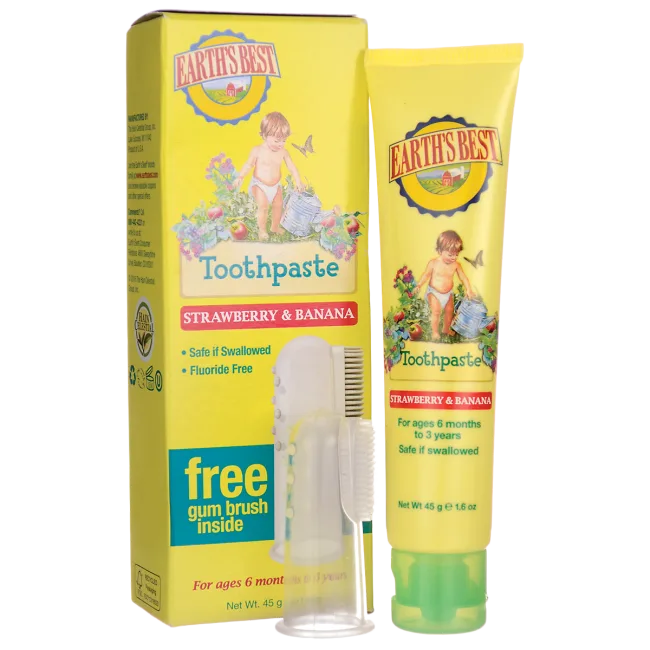
Pros
- Formulated with calcium lactate to boost teeth protection
- Very high-quality ingredients make it safe to swallow
Cons
- Packaging may be too childish for older children past the age of three
- Expensive for how much toothpaste you get in each tube
- Not a lot of flavor options
RiseWell Toothpaste
With a modern design and fun cartoon characters topping each tube, RiseWell Toothpaste is a fantastic option for younger children. Its formula is free of fluoride, SLS, sulfates, parabens, preservatives, or artificial colors and flavors.
This so-called mineral toothpaste claims to use hydroxyapatite instead of fluoride, a “naturally occurring mineral” that can coat and strengthen your child’s teeth. Completely safe to swallow and flavored like cake batter, I think very few children would object to it, particularly if your child is fond of baked goods.
While you won’t find RiseWell Mineral Toothpaste for Kids on Amazon, you can purchase a tube from the direct retailer. That said, though, it’s a bit on the pricey side. The brand doesn’t offer free shipping until you hit a minimum purchase threshold, either, which can be a bit of a turn-off.
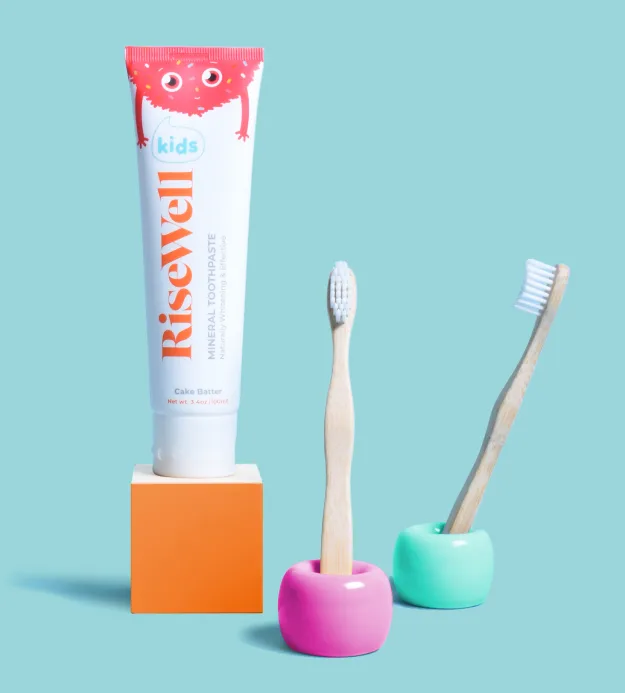
Pros
- Modern, friendly look appeals to kids without being too over the top
- Inclusion of hydroxyapatite makes it better at protecting teeth than non-fluoride toothpaste
- Developed by dentists
Cons
- Only one flavor option to choose can be limiting
- Difficult to find through third-party retailers
- On the more expensive side
Tom’s of Maine Children’s Toothpaste
With cute smiling fruit on the packaging, Tom’s of Maine offers fantastic children’s toothpaste at a surprisingly affordable price. At a fraction of the price per tube compared to other brands, this children’s toothpaste is less expensive than most of the options on this list so far.
Plus, it’s made with natural ingredients – such as glycerin derived from vegetable oils and purified silica from natural sources – as well as a variety of fruit juices for flavoring. While this toothpaste does include a small amount of fluoride for anticavity protection, the amount is much smaller than adult toothpaste.
It also avoids chemical foaming agents or preservatives and claims to be vegan and not tested on animals. This toothpaste is a great option for younger children who have started to become accustomed to rinsing toothpaste out rather than swallowing.
However, parents who are just starting to teach their kids how to brush their teeth might want to look elsewhere, as Tom’s of Maine doesn’t state that this toothpaste is 100% safe to swallow. Nonetheless, it’s a great option for children who don’t need to be monitored as closely when brushing.
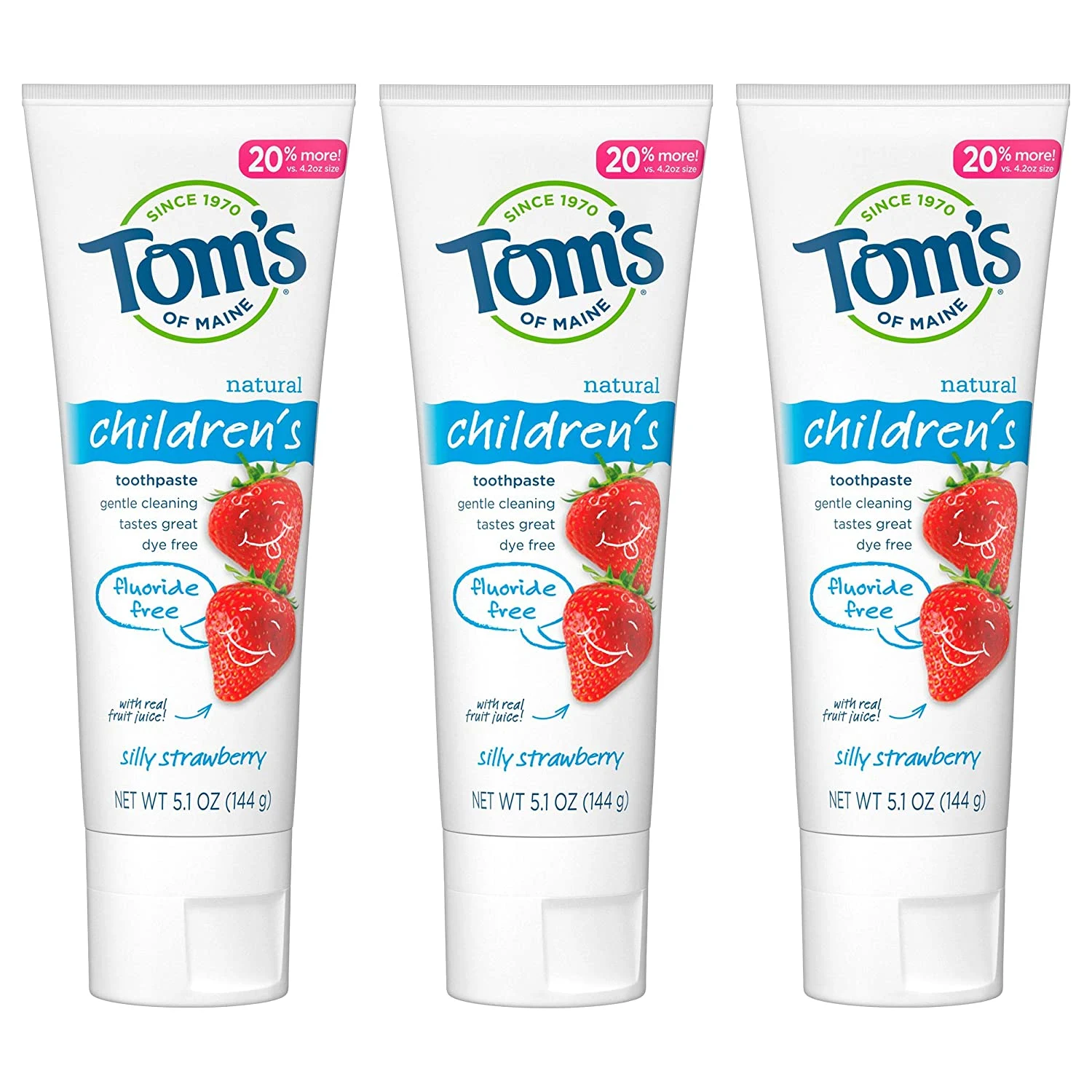
Pros
- Inclusion of fluoride means this toothpaste offers better dental protection
- High-quality fruit-based flavors rather than artificial flavorings
- Inexpensive compared to other options
Cons
- Not completely safe to swallow
- Calcium and silica abrasives may hurt sensitive teeth or gums
Burt’s Bees Fluoride Free Kids Toothpaste
This classic brand known for creating fantastic lip products is also the maker of some pretty awesome children’s toothpaste. Burt’s Bees Fluoride Free Kids Toothpaste is made without fluoride as the name suggests, and also avoids using SLS, preservatives, or artificial dyes.
The entire packaging, which depicts some adorable cartoon fruit along with Burt’s Bees’ characteristic bee-theme iconography, is completely recyclable. The toothpaste uses stevia-based sweeteners, as well as other natural flavorings for its “fruit fusion” flavor. Even though the company only offers a single flavor, it’s pretty tasty, if I do say so myself!
The toothpaste is also entirely safe to swallow. That said, parents with children who have learned to brush on their own may wish to explore some of Burt’s Bees’ other options that use fluoride if they want to maximize the effectiveness of teeth protection in their toothpaste.
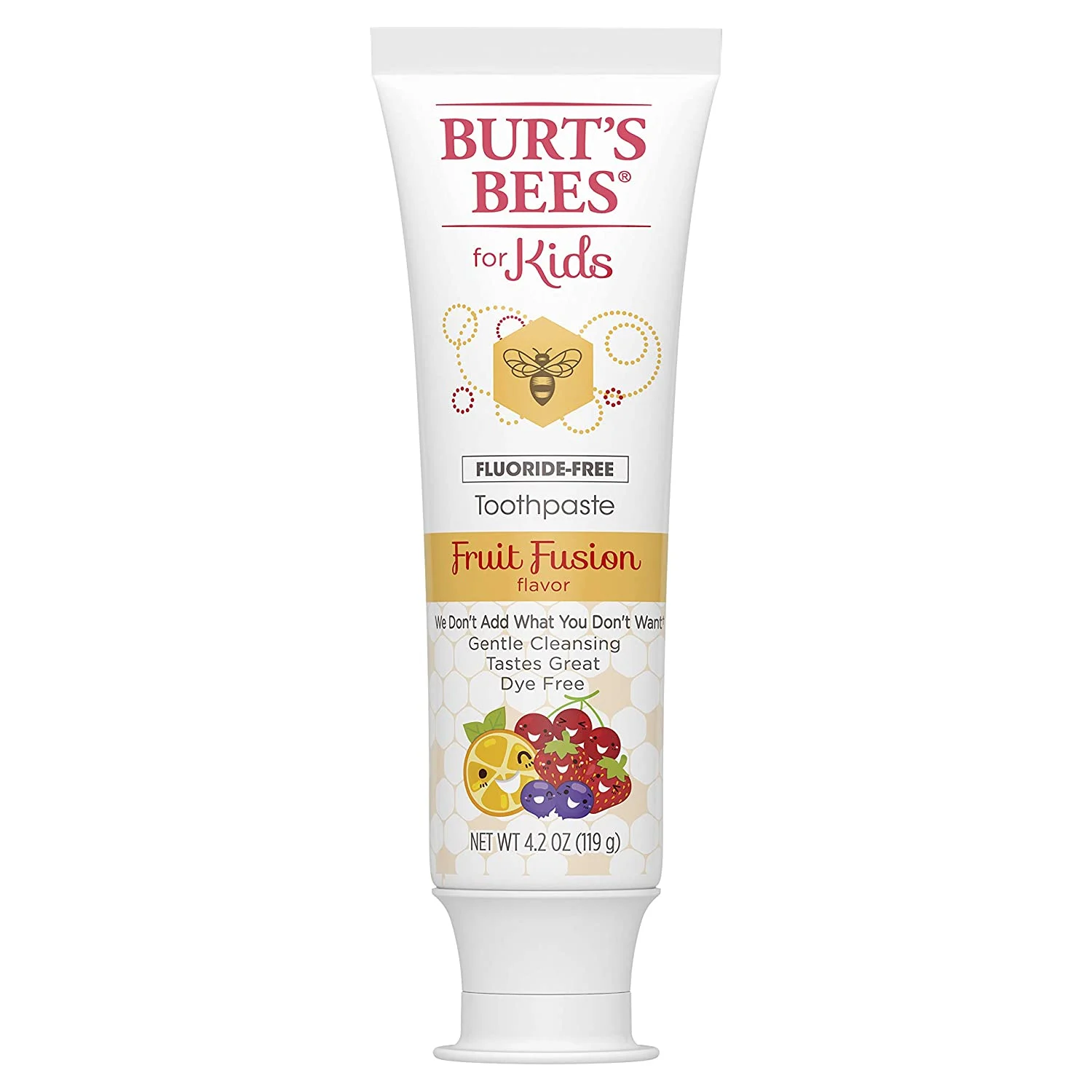
Pros
- Cute and friendly packaging to interest children
- Environmentally responsible packaging
- Safe to swallow
- Very affordable price
Cons
- Only one flavor option
- May not offer the same protection as fluoride toothpaste
Best Use Tips
While natural toothpaste for kids offers a lot of unique and incredible advantages compared to their conventional counterparts, natural toothpaste also present some drawbacks that parents should take into consideration before choosing a toothpaste for their child.
Fluoride Versus Non-fluoride Toothpaste
While fluoride can be dangerous when ingested, it’s also a very important ingredient in both natural and conventional toothpaste for making sure your teeth stay healthy. Fluoride is so critical to dental health that many cities add fluoride to the water supply that runs through your tap.
Parents looking for toothpaste for their children should consider where their child is at in their journey to start brushing their teeth. If your child can be trusted not to swallow their toothpaste regularly, it might be a good idea to purchase a natural toothpaste that uses fluoride.
Quality Versus Affordability
Another important consideration for many families is affordability. While natural toothpaste isn’t ridiculously more expensive compared to their drugstore counterparts, they do tend to be a few dollars extra on average.
Raising a child comes with many expenses, some of which are much more important than what toothpaste your child is using. Families struggling with financial commitments may wish to look at child-safe conventional toothpaste rather than natural toothpaste.
Children’s Versus Adult’s Toothpaste

Children’s toothpaste is specifically formulated for the delicate nature of young children’s developing teeth. These toothpastes tend to use different abrasive agents and other ingredients to account for the differences in how young children’s teeth react to irritants.
However, abrasive agents are also an important factor in teeth cleaning and whitening. If your child is on the older side, it might be worth considering switching to an adult toothpaste for the sake of better cleaning and whitening over the long term.
Frequently Asked Questions
Answer: Fluoride is a mineral that helps strengthen the outer layer of teeth. Ingesting too much fluoride can have dangerous health consequences, though, which is why it’s always very important to monitor your children when they’re still learning how to brush.
Answer: The Centers for Disease Control (CDC) recommends that parents use fluoride-free toothpaste until the age of two.
Answer: Parents often help brush their children’s teeth until the age of seven or eight.
Answer: The American Dental Association (ADA) recommends that children under the age of three use a rice grain-sized amount of toothpaste, while children older than that can use a pea-sized amount.
Answer: Yes, but extremely cold water (or other drinks) should be avoided if your child has sensitive teeth.
My Final Thoughts
Natural toothpaste is a fantastic option for children of all ages. Whether you choose natural toothpaste with or without fluoride, you can be confident that your child is brushing with the safest and highest quality ingredients possible.
While I recommend Burt’s Bees Fluoride Free Kids Toothpaste as my top pick, you definitely can’t go wrong with any of the others I’ve mentioned here today. And hopefully, with this list of best natural toothpaste for kids in hand, you’ll be able to easily find the right one for the youngest members of your family!

